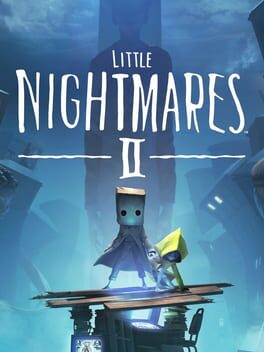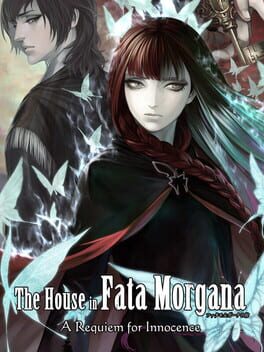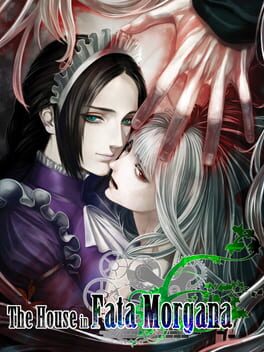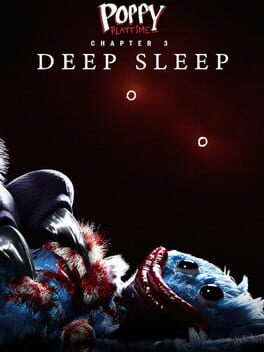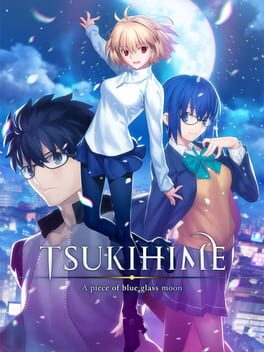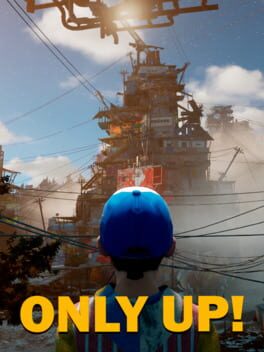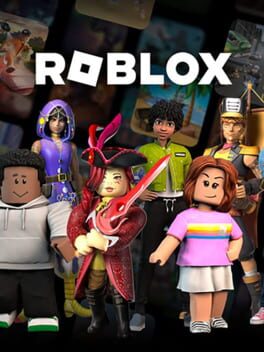notPara
2021
Being one of the few games out there that is able to combine the concepts of platformer and thriller in the same space, outside of what PlayDead managed to achieve with Limbo and INSIDE, what Tarsier Studios managed to achieve with Little Nightmares is certainly worth celebrating. The first game succeeded in building a world full of mystery that invited curiosity to dive deeper and the same can be said with the sequel that is even greater than the first one.
Trying to explain in detail and precisely the story behind the mystery of Little Nightmares can be said to be almost impossible. Tarsier decided to inject a storytelling style without dialogue from the beginning of the story to the end, which is also implemented in Little Nightmares II. Cutscenes that sometimes appear at some point in the story are positioned more for dramatization than to explain what actually happened. You'll end up creating your own personal interpretation. One thing is certain, you play as a boy character named Mono who wakes up in a forest with no clarity about what happened in the past. Mono's attempt to get out of the forest turns out to make him meet another character, Six the protagonist of the first game. Under the conditions where both of them are facing the same source of threat, Mono and Six decide to work together to save themselves. Slowly but surely, they found something that seemed to be the main source of the problem.
This journey finally took them to a large city called Pale City which apparently contained a type of monster that was not much different from what they had found before. Both of them could clearly see a tall tower in the middle of the city which was believed to be the Signal Tower, a frequency transmitting tower which ended up making many of the residents of Pale City change and behave like what they found. It became Mono and Six's ambition to examine this tower and perhaps, destroy it.
If we talk about what Tarsier managed to achieve with Little Nightmares II, the lore and mystery are now much bigger than the first game. If in the first game, you were "only" trapped in The Maw, a small sea location but filled with lots of monsters, Little Nightmares II will prove to you that the problem is not locked only there. Your trip to Pale City, although it won't give you much room for thorough exploration, will open your eyes to the fact that the presence of these unexplained monsters is something that occurs on a wider scale. And because of that, it makes the mystery of Little Nightmares not only deeper, but also scarier.
Just like in the first game, this sequel is ready to make you shudder through the variety of monster designs it offers, especially those that lead the chapters you pass. First, because each of these monsters has a strong association with death. There is no HP system in Little Nightmares II, where it only takes one attack to finish off Mono instantly. The giant monsters that are the "leaders" in this variety of levels are usually large, have faster and more agile movements, and have quite a long attack range if you don't manage to dodge. Second, like in the first game, they always appears in half-human form. They shares a human-like form, showing traces of humanity, but with extra body parts, behavior, and animation that are no longer human at all. This makes Little Nightmares II even more goosebump-inducing.
However, of all aspects of the atmosphere supporting presentation that i think is effective, is the audio processing capabilities that play the most important role in building the existing atmosphere. Little Nightmares II again doesn't fall into the “jump scare” format of scaring you, which made me the more when i think about it. The tense atmosphere is built not only from the visual side, but also the silence that makes the slightest sound end up attracting your attention. Coupled with the small details, from the sound of the mannequins's joints moving, the chalk scratching on the blackboard, to the sound of the television playing softly in the distance, your ears will continue to be alert. It will also be supported by music designed in such a way, to support the moving plot.
Another thing that stood out to me is Six, even though his position as the main protagonist has been shifted in Little Nightmares II, the presence of Six as a companion character in this second series for Mono is still a Tarsier strategy that deserves to be welcomed with open arms. Extra appreciation is expressed because for the size of the companion character, he is supported by AI which is also fantastic, opening up space for new mechanics for this game.
And for the essence of Little Nightmares II's gameplay is still the same as the first game. It is still a platformer game that at some point will challenge you with two thing, puzzles or the dexterity of your character's control. Puzzles of course require you to think coherently, about what kind of solution is needed to simply get the key or move to the next location. Meanwhile, quite a few will test your dexterity, where you have to run as quickly and effectively as possible to the next area, which is usually followed by monsters hunting you behind. For chase missions like this, sometimes they appear straightforward, but quite a few end up asking you to hide in a certain location instead of continuing to run.
I can say too that this sequel has an adrenaline-rush experience from the first chapter unlike the first game that took quite a couple of time to happened. In the forest (the first chapter) for example, you will meet a hunter who, instead of chasing and catching you, relies more on the rifle he has. Therefore, looking for cover every time he managed to reload the shotgun would be an important strategy, before moving to the next location. In the School chapter (the second chapter), masks to disguise themselves as one of the students are now injected into existing mechanics. In the hospitals (the third chapter) which is the scariest part for me, mannequins that are only active in the dark will lurk in every corner that you fail to illuminate using the flashlight in your hand which is the only light source that can able to stop the movement of scary mannequins that can only maneuver in the dark.
Tarsier did a fantastic job with Little Nightmares II. They maintain almost everything that the fans like from the first Little Nightmares, provide slight modifications through new abilities that can be executed by Mono and Six as a companion, and then inject a wider lore to take you into a deeper abyss of the mystery of the world. All of this is wrapped in a monster design that is still equally disgusting and scary, with silence and music that plays the atmosphere just right. Extra appreciation also deserves to be given to the scares and anxieties that don't rely on cheap jump scares at all. Little Nightmares II appears as a sequel series in its proper capacity. Retaining the components that made the first game so beloved, expanding the lore and variety of mechanics, building enough atmosphere to make you shudder, and ultimately deepening the mystery itself.
Trying to explain in detail and precisely the story behind the mystery of Little Nightmares can be said to be almost impossible. Tarsier decided to inject a storytelling style without dialogue from the beginning of the story to the end, which is also implemented in Little Nightmares II. Cutscenes that sometimes appear at some point in the story are positioned more for dramatization than to explain what actually happened. You'll end up creating your own personal interpretation. One thing is certain, you play as a boy character named Mono who wakes up in a forest with no clarity about what happened in the past. Mono's attempt to get out of the forest turns out to make him meet another character, Six the protagonist of the first game. Under the conditions where both of them are facing the same source of threat, Mono and Six decide to work together to save themselves. Slowly but surely, they found something that seemed to be the main source of the problem.
This journey finally took them to a large city called Pale City which apparently contained a type of monster that was not much different from what they had found before. Both of them could clearly see a tall tower in the middle of the city which was believed to be the Signal Tower, a frequency transmitting tower which ended up making many of the residents of Pale City change and behave like what they found. It became Mono and Six's ambition to examine this tower and perhaps, destroy it.
If we talk about what Tarsier managed to achieve with Little Nightmares II, the lore and mystery are now much bigger than the first game. If in the first game, you were "only" trapped in The Maw, a small sea location but filled with lots of monsters, Little Nightmares II will prove to you that the problem is not locked only there. Your trip to Pale City, although it won't give you much room for thorough exploration, will open your eyes to the fact that the presence of these unexplained monsters is something that occurs on a wider scale. And because of that, it makes the mystery of Little Nightmares not only deeper, but also scarier.
Just like in the first game, this sequel is ready to make you shudder through the variety of monster designs it offers, especially those that lead the chapters you pass. First, because each of these monsters has a strong association with death. There is no HP system in Little Nightmares II, where it only takes one attack to finish off Mono instantly. The giant monsters that are the "leaders" in this variety of levels are usually large, have faster and more agile movements, and have quite a long attack range if you don't manage to dodge. Second, like in the first game, they always appears in half-human form. They shares a human-like form, showing traces of humanity, but with extra body parts, behavior, and animation that are no longer human at all. This makes Little Nightmares II even more goosebump-inducing.
However, of all aspects of the atmosphere supporting presentation that i think is effective, is the audio processing capabilities that play the most important role in building the existing atmosphere. Little Nightmares II again doesn't fall into the “jump scare” format of scaring you, which made me the more when i think about it. The tense atmosphere is built not only from the visual side, but also the silence that makes the slightest sound end up attracting your attention. Coupled with the small details, from the sound of the mannequins's joints moving, the chalk scratching on the blackboard, to the sound of the television playing softly in the distance, your ears will continue to be alert. It will also be supported by music designed in such a way, to support the moving plot.
Another thing that stood out to me is Six, even though his position as the main protagonist has been shifted in Little Nightmares II, the presence of Six as a companion character in this second series for Mono is still a Tarsier strategy that deserves to be welcomed with open arms. Extra appreciation is expressed because for the size of the companion character, he is supported by AI which is also fantastic, opening up space for new mechanics for this game.
And for the essence of Little Nightmares II's gameplay is still the same as the first game. It is still a platformer game that at some point will challenge you with two thing, puzzles or the dexterity of your character's control. Puzzles of course require you to think coherently, about what kind of solution is needed to simply get the key or move to the next location. Meanwhile, quite a few will test your dexterity, where you have to run as quickly and effectively as possible to the next area, which is usually followed by monsters hunting you behind. For chase missions like this, sometimes they appear straightforward, but quite a few end up asking you to hide in a certain location instead of continuing to run.
I can say too that this sequel has an adrenaline-rush experience from the first chapter unlike the first game that took quite a couple of time to happened. In the forest (the first chapter) for example, you will meet a hunter who, instead of chasing and catching you, relies more on the rifle he has. Therefore, looking for cover every time he managed to reload the shotgun would be an important strategy, before moving to the next location. In the School chapter (the second chapter), masks to disguise themselves as one of the students are now injected into existing mechanics. In the hospitals (the third chapter) which is the scariest part for me, mannequins that are only active in the dark will lurk in every corner that you fail to illuminate using the flashlight in your hand which is the only light source that can able to stop the movement of scary mannequins that can only maneuver in the dark.
Tarsier did a fantastic job with Little Nightmares II. They maintain almost everything that the fans like from the first Little Nightmares, provide slight modifications through new abilities that can be executed by Mono and Six as a companion, and then inject a wider lore to take you into a deeper abyss of the mystery of the world. All of this is wrapped in a monster design that is still equally disgusting and scary, with silence and music that plays the atmosphere just right. Extra appreciation also deserves to be given to the scares and anxieties that don't rely on cheap jump scares at all. Little Nightmares II appears as a sequel series in its proper capacity. Retaining the components that made the first game so beloved, expanding the lore and variety of mechanics, building enough atmosphere to make you shudder, and ultimately deepening the mystery itself.
2022
I am not alone in this empty blood ocean
Horror has been a beloved genre for millions of people for a century now and that can also be said with video games. A great horror game will make you think about it for a couple hours after you finish it, it will send you into a depressing vegetative state and i can't think of anything that has done something like that in recent time other than Iron Lung. You see, for years i have played so many horror games from many different titles and what i can learn from those experiences is that horror can really expose the fear that every person have. Fear of dark, fear of enclosed space, fear of deep sea, fear of loud noises, fear of blood, these are just an example that horror genre used often for so long. But there is one fear that i think most people couldn't stand or dealt with and that is the fear of the unknown.
Short but powerful, that is a sentence that i can describe Iron Lung. It set in an ocean of blood on an alien moon in the wake of the “Quiet Rapture," which is one of the scariest description for an apocalypse i've ever seen, an event which saw the disappearance of every lifeform in the universe with the exception of people living on autonomous space stations. After every known star and planet in the universe disappears, the last remnants of humanity send a prisoner, namely you as the player to the depth of this strange moon covered in a sea of blood to explore what secrets may lie beneath its surface in a submarine. And you never know what is inside of the moon. The only thing you see is the inside of the small submarine you have welded together, and the low resolution images you can take of the inside.
The gameplay might be simple but it is what makes the game more intense and scarier which makes me more appreciate it. You navigate the ocean by adjusting your bearing, and forward velocity via a simple interface. You press the right button on your console to turn right, and the left button to turn left. You press the forward button to go forward, and the backward facing button to go backwards. It is simple, and slow. Your camera is controlled by a button at the back of your ship. To see where you are going you have to turn around and walk away from your controls. This means that, when you hear a thud outside your ship, there is a significant delay between the sound and your ability to take a photo of what made that noise. The photographs take a moment to develop and the delay makes me crazy, sick, feelings that i have not feel before with horror games because you are not alone in the craters of this impossibly alive, alien moon.
That aspect of Iron Lung is what keeps me still thinking and put me in state that i have never experience before in my life. A simple tension that comes from blindly navigating your sub, constantly looking at the map to try to figure out what you are to make sure you don’t crash your sub. It’s a finicky process, but focusing on the little things does a great job of lulling you into a rhythm and keeping you from bracing yourself for surprises. It keeps you busy with all the numbers and navigation controls that sometimes can messes you up. There are moments where you’re looking at the map and you feel like you shouldn’t be close to a wall, but for some reason, your motion sensor starts beeping at you. Do you have your calculations wrong, or could it be something else?
Even more so than most horror games, Iron Lung builds tension through exceptional sound design. Your ship is thick with the noise of the ocean, the thud of cave walls and the sound of blood (thick) moving around your ship. The sounds of the ocean around you range from mundane to worrying as you begin to suspect there are creatures out there that you have no way of seeing.
After i read the intro text states that there’s no time to train the prisoner on the operation of the sub before launch, i was certain that I was going to die. Whether it be from a lack of oxygen, or the crushing pressure, or some impossible thing in the blood water, didn’t actually matter. I knew I would die. Which meant the assumption of death, and horror, lurks around every corner. Every thud against the ship’s hull became colored by death. Every ruptured pneumatic pipe, a signal that my time was up. And of course the screen that showed you everything that you don't want to know about the moon.
Iron Lung is a game that evokes the end of a broken world, one defined by cruel systems which we built foolishly. Your investigation, and your focus, are cruel pantomimes of an attempt at a better future. It is an inevitable failure, and an execution. In most horror games, there's at least a hope that'll make it out alive and return to normalcy, but in Iron Lung there is no normalcy to return to.
Horror has been a beloved genre for millions of people for a century now and that can also be said with video games. A great horror game will make you think about it for a couple hours after you finish it, it will send you into a depressing vegetative state and i can't think of anything that has done something like that in recent time other than Iron Lung. You see, for years i have played so many horror games from many different titles and what i can learn from those experiences is that horror can really expose the fear that every person have. Fear of dark, fear of enclosed space, fear of deep sea, fear of loud noises, fear of blood, these are just an example that horror genre used often for so long. But there is one fear that i think most people couldn't stand or dealt with and that is the fear of the unknown.
Short but powerful, that is a sentence that i can describe Iron Lung. It set in an ocean of blood on an alien moon in the wake of the “Quiet Rapture," which is one of the scariest description for an apocalypse i've ever seen, an event which saw the disappearance of every lifeform in the universe with the exception of people living on autonomous space stations. After every known star and planet in the universe disappears, the last remnants of humanity send a prisoner, namely you as the player to the depth of this strange moon covered in a sea of blood to explore what secrets may lie beneath its surface in a submarine. And you never know what is inside of the moon. The only thing you see is the inside of the small submarine you have welded together, and the low resolution images you can take of the inside.
The gameplay might be simple but it is what makes the game more intense and scarier which makes me more appreciate it. You navigate the ocean by adjusting your bearing, and forward velocity via a simple interface. You press the right button on your console to turn right, and the left button to turn left. You press the forward button to go forward, and the backward facing button to go backwards. It is simple, and slow. Your camera is controlled by a button at the back of your ship. To see where you are going you have to turn around and walk away from your controls. This means that, when you hear a thud outside your ship, there is a significant delay between the sound and your ability to take a photo of what made that noise. The photographs take a moment to develop and the delay makes me crazy, sick, feelings that i have not feel before with horror games because you are not alone in the craters of this impossibly alive, alien moon.
That aspect of Iron Lung is what keeps me still thinking and put me in state that i have never experience before in my life. A simple tension that comes from blindly navigating your sub, constantly looking at the map to try to figure out what you are to make sure you don’t crash your sub. It’s a finicky process, but focusing on the little things does a great job of lulling you into a rhythm and keeping you from bracing yourself for surprises. It keeps you busy with all the numbers and navigation controls that sometimes can messes you up. There are moments where you’re looking at the map and you feel like you shouldn’t be close to a wall, but for some reason, your motion sensor starts beeping at you. Do you have your calculations wrong, or could it be something else?
Even more so than most horror games, Iron Lung builds tension through exceptional sound design. Your ship is thick with the noise of the ocean, the thud of cave walls and the sound of blood (thick) moving around your ship. The sounds of the ocean around you range from mundane to worrying as you begin to suspect there are creatures out there that you have no way of seeing.
After i read the intro text states that there’s no time to train the prisoner on the operation of the sub before launch, i was certain that I was going to die. Whether it be from a lack of oxygen, or the crushing pressure, or some impossible thing in the blood water, didn’t actually matter. I knew I would die. Which meant the assumption of death, and horror, lurks around every corner. Every thud against the ship’s hull became colored by death. Every ruptured pneumatic pipe, a signal that my time was up. And of course the screen that showed you everything that you don't want to know about the moon.
Iron Lung is a game that evokes the end of a broken world, one defined by cruel systems which we built foolishly. Your investigation, and your focus, are cruel pantomimes of an attempt at a better future. It is an inevitable failure, and an execution. In most horror games, there's at least a hope that'll make it out alive and return to normalcy, but in Iron Lung there is no normalcy to return to.
Well well well we are back yet again with the path of depression and if you think in my last review The House in Fata Morgana is a painful, heartbreaking journey then the prequel, A Requiem for Innocence doubles all of those emotions that you experienced when playing the base game and it's very very worth it to play after you finish the base game.
A Requiem for Innocence primarily focuses on the backstory and relationship between Jacopo and Morgana, delved into much deeper detail of their relationship that the original game briefly explained in their earlier days before the tragedy we know too well befalls them. Basically retelling of what happened during the last door in the main game not including Michel’s meddling with Morgana’s memories, but things as they happened before Morgana turned into the witch that tormented those around her for around a thousand years.
The character growth and ultimate destruction of Jacopo is another highlight of A Requiem for Innocence. It’s also amazing to see how so many characters could have changed things massively for the better if only they’d taken the opportunity to do so. In many ways, this is an incredibly heartbreaking tale, and absolutely should not be missed. It’s so painful and heartbreaking to see Jacopo come so, so close to being a great man and to have that just thrown away, bit by bit, by a combination of short-sightedness, misunderstandings, and a sense of desperate self-preservation. However it does help the reader to understand his character a bit more although sympathy is less felt than disappointment in his actions. It really is like a snowball effect where all these little mistakes accumulate little by little and before he knows it, he’s on the path of no return.
When I see Jacopo and Morgana's story, I can't help but feel like this is the most interesting interpretation of the "Beauty and Beast" story. Jacopo stared off as a good person, but power corrupted him. However, his feelings for Morgana are genuine and sweet. Enough to make him lament his actions to the point of near self-destruction. After living through three lives, he earns the chance to fulfil the promise he made to Morgana all those years ago. Morgana, despite having been hurt so badly by Jacopo's actions, learned compassion from Michel which lead her to save Jacopo from his self-inflicted curse. Even though she never forgave him, she remembered who he was and could still be. In the last life, she still couldn't bring herself to forgive him, but she saw that he was no longer the man seeking fame and fortune anymore. He was the man she saw before. the man who was kind to her in his own way. Who cared for her despite her childish antics, who would followed her through hail and rain to stay by her side. Together, they overcame their own flaws and personal herdles, and came out as better people thanks to the efforts and effects of the other. And the best part, we as the reader see it as it happens slowly, no snapshot redemptions, no instant forgiveness. Just two people working their way through life.
On top all of that you get a bonus chapter called 'Fragment' which just breaks your soul ten times more and what i like from Fragment is that Jacopo is a lot more forward in his feelings for her and fucking hell it’s just so heartwrenching because it makes me think of what “could have been” had they sat down and expressed their feelings openly towards one another. And just like the base game, once you have completed the game the main title screen changed, it is just perfect down to the last minute detail.
To Jacopo and Morgana i'm wishing nothing but happiness in your next life.
A Requiem for Innocence primarily focuses on the backstory and relationship between Jacopo and Morgana, delved into much deeper detail of their relationship that the original game briefly explained in their earlier days before the tragedy we know too well befalls them. Basically retelling of what happened during the last door in the main game not including Michel’s meddling with Morgana’s memories, but things as they happened before Morgana turned into the witch that tormented those around her for around a thousand years.
The character growth and ultimate destruction of Jacopo is another highlight of A Requiem for Innocence. It’s also amazing to see how so many characters could have changed things massively for the better if only they’d taken the opportunity to do so. In many ways, this is an incredibly heartbreaking tale, and absolutely should not be missed. It’s so painful and heartbreaking to see Jacopo come so, so close to being a great man and to have that just thrown away, bit by bit, by a combination of short-sightedness, misunderstandings, and a sense of desperate self-preservation. However it does help the reader to understand his character a bit more although sympathy is less felt than disappointment in his actions. It really is like a snowball effect where all these little mistakes accumulate little by little and before he knows it, he’s on the path of no return.
When I see Jacopo and Morgana's story, I can't help but feel like this is the most interesting interpretation of the "Beauty and Beast" story. Jacopo stared off as a good person, but power corrupted him. However, his feelings for Morgana are genuine and sweet. Enough to make him lament his actions to the point of near self-destruction. After living through three lives, he earns the chance to fulfil the promise he made to Morgana all those years ago. Morgana, despite having been hurt so badly by Jacopo's actions, learned compassion from Michel which lead her to save Jacopo from his self-inflicted curse. Even though she never forgave him, she remembered who he was and could still be. In the last life, she still couldn't bring herself to forgive him, but she saw that he was no longer the man seeking fame and fortune anymore. He was the man she saw before. the man who was kind to her in his own way. Who cared for her despite her childish antics, who would followed her through hail and rain to stay by her side. Together, they overcame their own flaws and personal herdles, and came out as better people thanks to the efforts and effects of the other. And the best part, we as the reader see it as it happens slowly, no snapshot redemptions, no instant forgiveness. Just two people working their way through life.
On top all of that you get a bonus chapter called 'Fragment' which just breaks your soul ten times more and what i like from Fragment is that Jacopo is a lot more forward in his feelings for her and fucking hell it’s just so heartwrenching because it makes me think of what “could have been” had they sat down and expressed their feelings openly towards one another. And just like the base game, once you have completed the game the main title screen changed, it is just perfect down to the last minute detail.
To Jacopo and Morgana i'm wishing nothing but happiness in your next life.
It's been a year since i finished The House in Fata Morgana and still to this day i regarded it as one of the greatest story ever written. From story development and unique characters and settings that are set in 3 time periods, with interconnected characters and stories to using modern Japanese with a little 'flavor' of language from ancient times, which makes The House in Fata Morgana adapted to the current era. All of that provides a tense, sad atmosphere and at the same time a bit of comedy. However, the story in Fata Morgana is available in 7 Bad Endings and 1 True Ending, where the true ending of this visual novel gave me a cool breeze for my heart which has been holding back emotions since the story began.
The House in Fata Morgana has 8 different stories to tell throughout the entire story or what they call them "door". The story is set in one main setting, an old mansion which has a dark history starting from the persecution of a girl known as a 'witch' to the story of the protagonist 'you' and the maid welcomes you, sees your condition, and offers to give you a tour, which she hopes will help you jog your memory. Each room leads to you viewing various memories of past events that have taken place there. These memories are quite memorable, and set the stage for future revelations, even if it’s quite subtle in how it does it.
The first story tells the story of a brother and sister who live peacefully and freely with their family, until a mysterious white-haired and red-eyed girl comes to become a servant for the family.
The second story is probably the darkest part in this story for me, it tells of a 'monster' known as a sadistic murderer who lives in the big old house and a girl who is the same as the first story but in a different form enters the mysterious house. This story is extremely gruesome and graphic. Is it not for the faint of heart and I felt a little sick reading it at times.
The third story tells a wealthy businessman and his estranged relationship with his wife and the story behind that estranged relationship. It’s an incredibly moving story that shows how even the very best and self-sacrificing people have limits, and everyone will eventually break.
And from the fourth door to the last door or the eighth door becomes the main story which will discuss the past of the 'witch' who haunt the mansion, the servant girl, and the main character 'you', as well as their relationship with the three stories in the initial opening.
All of these stories have incredibly tragic ends, that could have been avoided with some other decision be it better communication, honesty, or repentance. But they serve to introduce characters that have a long-lasting effect on the overarching narrative, as well as establish the relevance of the mansion and its curse. Describing even a word past chapter three or door three leads too far down spoiler territory to say any more so i won't go deep into that.
There is quite a bit of foreshadowing as you expect from mystery genre like other titles, in even the simplest of events, and the story takes the time it needs to expound on each character, story, and theme. And that what makes The House in Fata Morgana's storytelling excellent.
Then you add another fantastic element on top of the writing which is the music because holy macaroonis they ain't lying when they said you have to experience it with headphone in the loading screen. Each character, scene, and mood is properly represented with a theme, that is sometimes really eerie with noises and sound effects, other times a moody piano, and often with simply incredible female vocals like the soundtracks 'Giselle' and 'Cicio'. The words are all in an ancient dialect of Portuguese, and sound very Latin and mysterious. Some of the songs will make your hair stand up, while others sound nearly reverent.
What i learn from The House in Fata Morgana is that wherever and whenever a person are there are people who will love and care for them until they wait for us to return and be by their side, revenge is not a good thing but you have to let go of it and move forward in a better direction. Life is a difficult thing where sometimes we encounter bad things and even tragedy, but behind it all there is a beautiful story.
All in all, The House in Fata Morgana is one of those tales that is incredibly well written, mature, dark, and bloody that explore the deepest, darkest depths of depravity in the human soul. Even though at first I was not used to the realist images of this visual novel, in the end I realized that the realist images and the choice not to use voice actors for each character were so that players could enjoy the story, and for me personally this visual novel has parts that can answer questions in life. An unrushed story with the characters each having their own reasons and backstories that portrayed what is sacrificial love looks like.
The House in Fata Morgana has 8 different stories to tell throughout the entire story or what they call them "door". The story is set in one main setting, an old mansion which has a dark history starting from the persecution of a girl known as a 'witch' to the story of the protagonist 'you' and the maid welcomes you, sees your condition, and offers to give you a tour, which she hopes will help you jog your memory. Each room leads to you viewing various memories of past events that have taken place there. These memories are quite memorable, and set the stage for future revelations, even if it’s quite subtle in how it does it.
The first story tells the story of a brother and sister who live peacefully and freely with their family, until a mysterious white-haired and red-eyed girl comes to become a servant for the family.
The second story is probably the darkest part in this story for me, it tells of a 'monster' known as a sadistic murderer who lives in the big old house and a girl who is the same as the first story but in a different form enters the mysterious house. This story is extremely gruesome and graphic. Is it not for the faint of heart and I felt a little sick reading it at times.
The third story tells a wealthy businessman and his estranged relationship with his wife and the story behind that estranged relationship. It’s an incredibly moving story that shows how even the very best and self-sacrificing people have limits, and everyone will eventually break.
And from the fourth door to the last door or the eighth door becomes the main story which will discuss the past of the 'witch' who haunt the mansion, the servant girl, and the main character 'you', as well as their relationship with the three stories in the initial opening.
All of these stories have incredibly tragic ends, that could have been avoided with some other decision be it better communication, honesty, or repentance. But they serve to introduce characters that have a long-lasting effect on the overarching narrative, as well as establish the relevance of the mansion and its curse. Describing even a word past chapter three or door three leads too far down spoiler territory to say any more so i won't go deep into that.
There is quite a bit of foreshadowing as you expect from mystery genre like other titles, in even the simplest of events, and the story takes the time it needs to expound on each character, story, and theme. And that what makes The House in Fata Morgana's storytelling excellent.
Then you add another fantastic element on top of the writing which is the music because holy macaroonis they ain't lying when they said you have to experience it with headphone in the loading screen. Each character, scene, and mood is properly represented with a theme, that is sometimes really eerie with noises and sound effects, other times a moody piano, and often with simply incredible female vocals like the soundtracks 'Giselle' and 'Cicio'. The words are all in an ancient dialect of Portuguese, and sound very Latin and mysterious. Some of the songs will make your hair stand up, while others sound nearly reverent.
What i learn from The House in Fata Morgana is that wherever and whenever a person are there are people who will love and care for them until they wait for us to return and be by their side, revenge is not a good thing but you have to let go of it and move forward in a better direction. Life is a difficult thing where sometimes we encounter bad things and even tragedy, but behind it all there is a beautiful story.
All in all, The House in Fata Morgana is one of those tales that is incredibly well written, mature, dark, and bloody that explore the deepest, darkest depths of depravity in the human soul. Even though at first I was not used to the realist images of this visual novel, in the end I realized that the realist images and the choice not to use voice actors for each character were so that players could enjoy the story, and for me personally this visual novel has parts that can answer questions in life. An unrushed story with the characters each having their own reasons and backstories that portrayed what is sacrificial love looks like.
What has not been said about Sons of Liberty, it's a complex and thought-provoking game that push the boundaries in terms of storytelling, gameplay mechanics, and thematic depth. It explores themes of reality, identity, free will, and the manipulation of information. Its narrative depth and philosophical undertones contribute to its status as a seminal work in the realm of video game storytelling. A timeless piece of art in the pantheon of video game masterpieces. Kojima is not from this world.
I went into the Vtuber rabbit hole back in 2019 and of course it was Hololive that introduced me to the world of Vtubing. So when a fan-made game of Hololive based on Vampire Survivors (i haven't play it and i might soon) called Holocure released i was really shocked and hype to try it out. It was fun, chaotic and addicting more than anything else.
Two things that made me appreciate this game every time i play it, the first one is that it has a gacha system for the characters but it won't cost you any payment instead the characters are unlocked by collecting coins in the game and then spending them a thousand at a time on an in-game gacha mechanic. Yu, the developer is keen to emphasise that the gacha is purely in-game currency and does not involve any sort of monetisation, you just need to play the game a few times to unlock the additional characters.
Second and this might be the best thing about Holocure is that you don't need to know anything whatsoever about Hololive to appreciate it. If you have never explored VTuber culture at all, the game’s intro sequence provides a brief bit of context, and from there the playable characters can all simply be seen as cute girls with unique abilities. At the other end of the spectrum, however, if you are deeply immersed into VTuber culture and Hololive culture specifically then the game is absolutely rammed full of references and in-jokes that will continually delight your experience.
Two things that made me appreciate this game every time i play it, the first one is that it has a gacha system for the characters but it won't cost you any payment instead the characters are unlocked by collecting coins in the game and then spending them a thousand at a time on an in-game gacha mechanic. Yu, the developer is keen to emphasise that the gacha is purely in-game currency and does not involve any sort of monetisation, you just need to play the game a few times to unlock the additional characters.
Second and this might be the best thing about Holocure is that you don't need to know anything whatsoever about Hololive to appreciate it. If you have never explored VTuber culture at all, the game’s intro sequence provides a brief bit of context, and from there the playable characters can all simply be seen as cute girls with unique abilities. At the other end of the spectrum, however, if you are deeply immersed into VTuber culture and Hololive culture specifically then the game is absolutely rammed full of references and in-jokes that will continually delight your experience.
Disco Elysium is a brilliant and fantastic game, a combination of adjectives that are by no means an exaggeration to describe what ZA/UM managed to build. It was handled so neatly, sweetly, and full of charm. It's amazing how an RPG game without a combat system, which takes you through the process of investigating a murder case that requires you to read and take conversation options can end up as amazing and addictive as this. Everything is wrapped in an aesthetic approach, from visual to audio, which also deserves a thumbs up. There is beauty, there is despair, there is strangeness, there is madness, and there are emotional jumps that will make you fall in love with Disco Elysium as time goes by.
What makes Disco Elysium a beautiful game is first, Kim Katsuragi. Initially, Kim looked like a useless partner and added to the player's burden. He is ready to take preventive measures anytime and anywhere. Towards the end, Kim will always provide backup for the player, when solving cases or even when trying to solve mysteries about himself. He's a nice guy, after all. Kim's character is really formed as a helpful figure, but doesn't want to interfere too much in every decision the player makes.
Second, connections. I love every connection that occurs in this game. It's as if Disco Elysium started with each NPC moving individually but connected to each other in the end. You move freely in Revachol, but you don't know the big shadow that haunts you from every NPC there. Even as simple as a child named Cuno to a representative of port workers, Evrart Claire. It's like, I don't want to deal with you but I have to because you have something I need.
From my experience playing Disco Elysium, the first and second days felt more like "Go with the flow". Since the third day, every dialogue and action in the game creates a feeling of emptiness. Yep, it feels empty and raises hopes that there will be a bright spot in this mystery. In reality this feeling of emptiness is getting worse over time. It went like this until the last day. Disco Elysium closes the game with a 'blow' that was never imagined before, as if to close the case with the big question, "Why?"
What makes Disco Elysium a beautiful game is first, Kim Katsuragi. Initially, Kim looked like a useless partner and added to the player's burden. He is ready to take preventive measures anytime and anywhere. Towards the end, Kim will always provide backup for the player, when solving cases or even when trying to solve mysteries about himself. He's a nice guy, after all. Kim's character is really formed as a helpful figure, but doesn't want to interfere too much in every decision the player makes.
Second, connections. I love every connection that occurs in this game. It's as if Disco Elysium started with each NPC moving individually but connected to each other in the end. You move freely in Revachol, but you don't know the big shadow that haunts you from every NPC there. Even as simple as a child named Cuno to a representative of port workers, Evrart Claire. It's like, I don't want to deal with you but I have to because you have something I need.
From my experience playing Disco Elysium, the first and second days felt more like "Go with the flow". Since the third day, every dialogue and action in the game creates a feeling of emptiness. Yep, it feels empty and raises hopes that there will be a bright spot in this mystery. In reality this feeling of emptiness is getting worse over time. It went like this until the last day. Disco Elysium closes the game with a 'blow' that was never imagined before, as if to close the case with the big question, "Why?"
2023
2006
